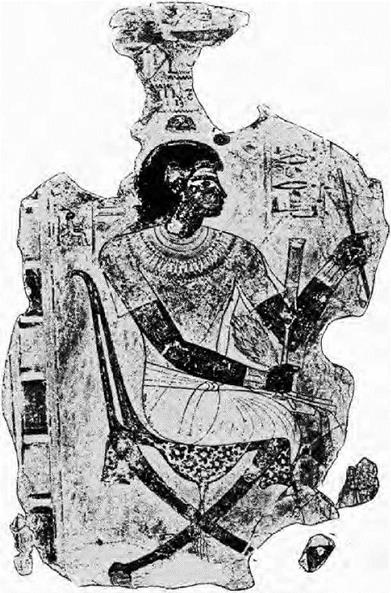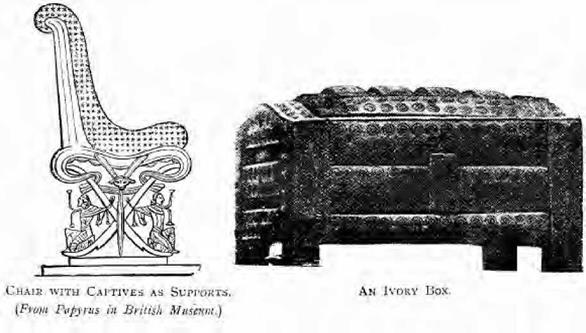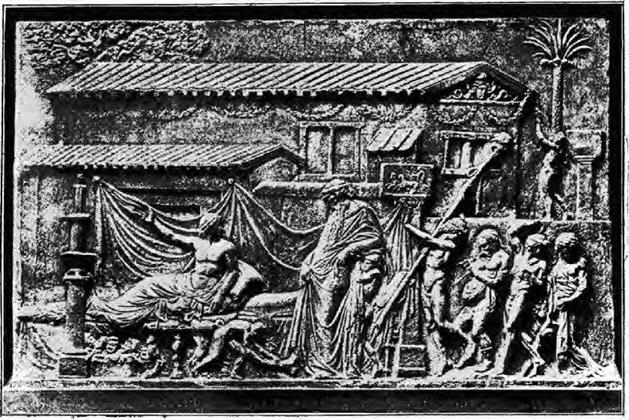 |
||
In the consideration of ancient Egyptian furniture we find valuable assistance in the examples carefully preserved to us, and accessible to everyone, in the British Museum, and one or two of these deserve passing notice.
1-’оьи!№ Stool. Ebonv Shat fNtrtin with Ivtjnv-
РЬоЩ! Lv IlfшііЩ Си. г/ tin org totals in tin British Mitsui»’)
Nothing can be more suitable for its purpose then the "Workman’s Stool:" the seat is precisely like that of a modern kitchen chair (all wood), slightly concaved to promote the sitter’s comfort, and supported by three legs curving outwards. This is simple, convenient, and admirably adapted for long service. For a specimen of more ornamental work, the folding stool in the same glass case should be examined; the supports are crossed in a similar way to those of a modern camp – stool, and the lower parts of the legs carved as heads of geese, with inlayings of ivory to assist the design and give richness to its execution.
|
AN EGYPTIAN OF HIGH RANK SEATED. (J’tOffl a Photo in1 Маннії &• Co. of the Original IVaU Pajnt:*g m the hutUh bfuswti.) Period: bc, 1500-1400. |
Portions of legs and rails, turned as if by a modern lathe, mortice holes and tenons, fill us with wonder as we look upon work which, at the most modern computation, must be 3,000 years old, and may be of a date still more remote.
 |
In the same room, arranged in cases round the wall, is a collection of several objects which, if scarcely to be classed under the head of furniture, are articles of luxury and comfort, and demonstrate the extraordinary state of civilisation enjoyed by the old Egyptians, and help us to form a picture of their domestic habits.
Amongst these are boxes inlaid with various woods, and also with little squares of bright turquoise blue pottery let in as a relief; others veneered with ivory; wooden spoons, carved in most intricate designs, of which one, representing a girl amongst lotus flowers, is a work of great artistic skill; boats of wood, head rests, and models of parts of houses and granaries, together with writing materials, different kinds of tools and implements, and a quantity of personal ornaments and requisites.
"For furniture, various woods were employed, ebony, acacia or sont, cedar, sycamore, and others of species not determined. Ivory, both of the hippopotamus and elephant, was used for inlaying, as also were glass pastes; and specimens of marquetry are not uncommon. In the paintings in the tombs, gorgeous pictures and gilded furniture are depicted. For cushions and mattresses, linen cloth and colored
stuffs, filled with feathers of the waterfowl, appear to have been used, while seats have plaited bottoms of linen cord or tanned and dyed leather thrown over them, and sometimes the skins of panthers served this purpose. For carpets they used mats of palm fibre, on which they often sat. On the whole, an Egyptian house was lightly furnished, and not encumbered with so many articles as are in use at the present day."
The above paragraph forms part of the notice with which the late Dr. Birch, the eminent antiquarian, formerly at the head of this department of the British Museum, has prefaced a catalogue of the antiquities alluded to. The visitor to the Museum should be careful to procure one of these useful and inexpensive guides to this portion of its contents.
Some illustrations taken from ancient statues and bas reliefs in the British Museum, from copies of wall paintings at Thebes, and other sources, give us a good idea of the furniture of this interesting people. In one of these will be seen a representation of the wooden head-rest which prevented the disarrangement of the coiffure of an Egyptian lady of rank. A very similiar head-rest, with a cushion attached for comfort to the neck, is still in common use by the Japanese of the present day.
|
|
|
BACCHUS AND ATTENDANTS VISITING ICARUS. (Rtfmltutd from a Bas-rettif in the BHtesh Museum. J P&nrOD. ДГҐ’ТІТ A, B. ІОО |






